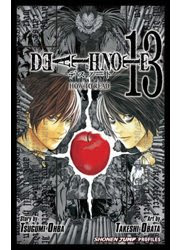 Book Info Book InfoRating: Overall= A |
Journal
Here, in one authoritative volume, is everything you need to know about Death Note! Features include complete character biographies, detailed story-line summaries, production notes, and behind-the-scenes commentaries. Death Note 13: How to Read also includes exclusive interviews with creators Tsugumi Ohba and Takeshi Obata and a bonus manga chapter of never-before-translated material. (Source: AnimeNation)
I was in Borders one day browsing through the manga section when I found some book about Death Note that claimed to reveal mysteries and secrets about the manga. Intrigued, I leafed through it. But after a few minutes I realized that the book contained nothing that I didn't already know about the series. All it did was summarize info that you could find out by reading the books or watching the anime. Essentially -- much like some Harry Potter books I've seen floating around -- it was nothing more than a worthless attempt by some shmoe to milk money out of a popular franchise. Death Note 13: How to Read, however, is NOT that type of book.
The best way I can think of to describe DN 13 is that it is comparable a really good set of DVD extras. From character bios to creator's commentary to making-of info and even some humorous extras, this book is the definitive Death Note encyclopedia.
Having said that, there is a lot in this book that you may already know. The character bios and timeline of events are nothing new; but it goes the extra mile in both the way it organizes the information and in the level of extra behind-the-scenes info it gives you.
For instance, in the character bios there is a chart that gages certain personality traits of each character. So you can see how the intelligence level of Light compares to L, or how the death toll of Ryuk compares to Rem. Plus it give more insight into the background, motivations, and likes/dislikes and even the physical traits like height, weight, blood type that you wouldn't necessarily know by reading the manga alone. So now you know everything from the degree of Mellow's inferiority complex to Halle Linder's distaste for moths. In addition the creators tell you things like how Misa probably ended up after her final scene and what probably happened with Light's mom and sister.
The book also organizes the story and characters in every which way imaginable. You have the timeline of events including specific dates. You have all the organizations involved, including which characters belong to which organization, and the part each plays. You have all of the Death Note rules including the ones that directly affect the story and the specific scenes they apply to as well as the ones that are never even mentioned in the manga. Plus you have a list of all the tricks that the characters employ when using the Death Note. You have a list of what characters used which Death Note... the list goes on and on. And even though some of the info is redundant, each section provides some new or extra detail or insight to glean from the story.
Of course, the biggest value to the book are the multiple interviews with the creators: Tsugumi Ohba (the writer) and Takeshi Obata (the artist). They go into everything from how they went about creating the series, to the level of collaboration, to how they came up with the character designs, to aspects of the creators' everyday lives. For instance, Ohba reveals that the story was never intended to be as deep as people interpret it. He never meant for it to spark debate about right vs. wrong or whether Light was good or evil. He just wanted to create an entertaining suspense story. And Ryuk's apples -- which so many people interpreted as a reference to Adam and Eve and temptation -- was merely used because he thought the red color would look cool against Ryuk's black body. Although the one thing that I was confused about was the level to which Ohba planned ahead when writing the story. At one point he says that he knew what the ending was going to be all along. But later on he said that he was pretty much just making up the story as he went. I'm guessing the real answer is somewhere in between.
The final parts of the book include a hilarious "Ryuk's Journal" section where Ryuk uncovers everything from Mello's scoreboard of victories and defeats to Near's shopping list to just how much sugar and caffeine L actually inhales. Then there are some funny four-panel comic strips and everything wraps up with the original never-before-seen pilot chapter on which the serial Death Note manga was based.
So -- if you haven't figured it out by now -- this book is more than just a regurgitation of info you already know. It provides useful insight and new details that -- if you are a true Death Note fanatic -- you won't want to be without.


No comments:
Post a Comment